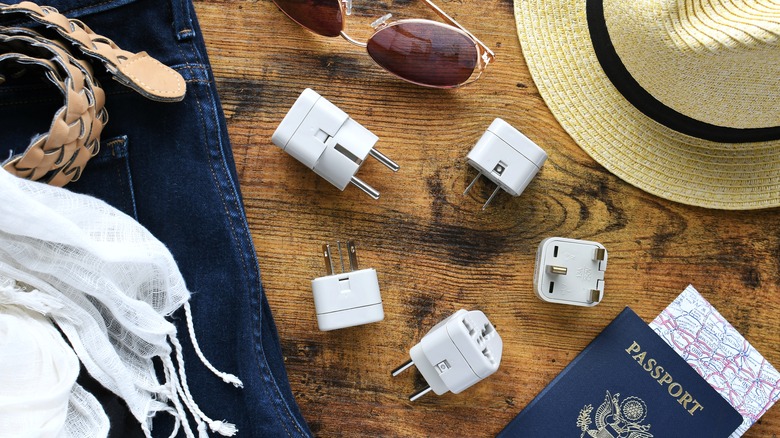What Would Happen If You Used An American Plug On A European Power Outlet?
These days, in addition to choosing the right clothing and gathering travel-sized toiletries to comply with the TSA's 3-1-1 rule, you have to consider electronics, especially if you're traveling to Europe. As you may know, the European Union and the United Kingdom use different plugs and operate on a higher voltage than the United States. That means anything you bring that needs to be plugged in, from your laptop to your phone to your hair dryer (since hotel hair dryers can have some gross bacteria in them), will likely need an adaptor for the plug shape and possibly a converter for the voltage.
Let's start with the plugs. First, you can't fit an American plug, which uses two flat prongs, and sometimes has a third half-circle prong, into a European power outlet. The United Kingdom uses three rectangular prongs, while much of continental Europe uses two round prongs. Italy uses two or three round prongs in a line, and Switzerland uses two or three prongs arranged in a triangle pattern. European outlets are often recessed as well.
That said, you'll need to purchase an adapter, which has one side that fits an American plug and another that matches the prongs of the local outlet. The good news, though, is if you forget to bring one, your hotel may have a spare, as travelers often leave them behind.
How to handle voltage differences between American and European outlets
The outlet and prong style may not be the only thing to worry about. The higher voltage used in European outlets can be also be an issue for American devices. As travel pro Rick Steves explains on his website, "American appliances run on 110 volts, while European appliances are 220 volts. Most gadgets are 'dual voltage,' which means they work on both American and European current." Newer devices like your laptop and phone are likely to handle both voltages, but older ones may not.
Some dual-voltage devices have a switch that lets you select one voltage level or the other. (Be sure to check each device you plan to plug in.) If your device has a switch, or you have a newer device that's already compatible with both, you won't need a voltage converter in addition to an adapter. However, if you plug something in that can't handle 220 volts without a converter, you may fry it, rendering it unusable.
You can purchase a combo adapter/converter, as some may have adapter plugs for the U.K., EU, and Australia, along with a multi-port USB charger and voltage conversion. Keep it in your carry-on so you can keep your phone charged when you land. If you bring a power bank, you can charge it using an adapter and then use the bank to charge your devices without needing one. Finally, while you're sorting through adapters, converters, and electronics, don't forget to pack your outdated wired headphones with an aux jack for the plane's in-flight entertainment system.

